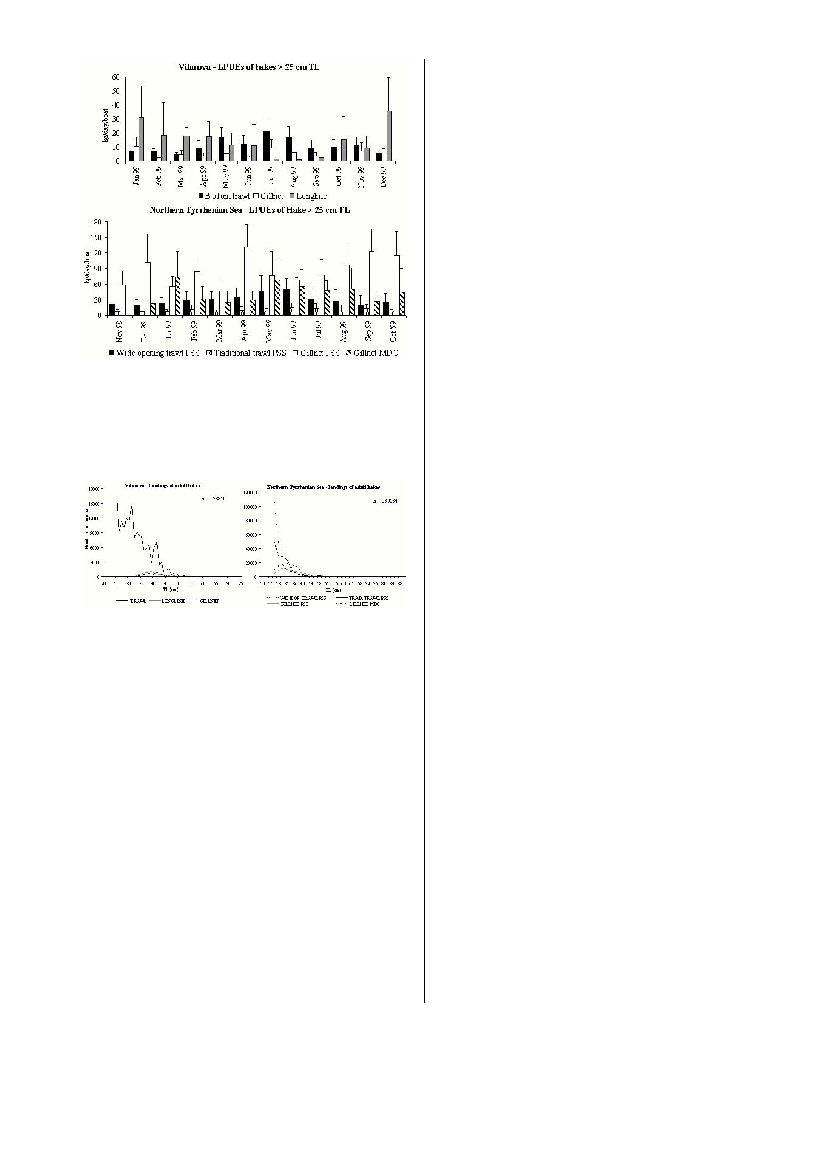Rapp. Comm. int. Mer Médit., 36,2001
322
Fig. 2 - Monthly landings per unit effort (kg/day/boat) of adult
M. merluccius, by gear and port.
Considering the landings in number of individuals, the contribution
due to trawling resulted even higher compared to that in biomass (Fig.
1). This was due to the fact that the adults landed by trawling were
smaller respect to those landed by the artisanal gears (Fig. 3).
Fig. 3 - Size structure of the annual landings of adult of M. mer-
luccius, by gear and port.
Comparing the demographic structure of the landings of each gear
with the Kolmogorov-Smirnov test, in Vilanova significant (p<0.001)
differences emerged in all the comparisons with trawling, while for
gillnet and longline no statistical differences were evidenced; in this
port the adult hake landings of trawling were mostly composed of
specimens till 35 cm TL, while the majority of those caught by arti-
sanal gears ranged from 35 to 45 cm TL. In the northern Tyrrhenian
Sea, significant (p<0.001) differences emerged from all the compar-
isons; landings of adult hakes by traditional trawling differed from
those of wide opening trawling for the greater importance of speci-
mens > 30cm TL in the landings of the first gear; gillnet of Marina di
Campo was mostly represented by specimens till 40 cm TL, while in
the gillnet of Porto Santo Stefano the specimens of bigger sizes result-
ed more important (Fig. 3).
References
(1) Relini G., Bertrand J. and Zamboni A. (eds) 1999. Synthesis of the
knowledge on bottom fishery resources in Central Mediterranean. Biol.
Mar. Medit., 6 (suppl. 1), 868 pp.
Introduction
The common sole, Solea vulgaris, Quensel 1806, is undoubtedly the
most important ?atfish in the Mediterranean Sea, both for its abun-
dance and economic value. According to FAO statistics (1) the annual
landings of S. vulgarisin this area increased from about 4500 tons in
1972 to about 10000 tons in 1992. The fishing activity is mostly car-
ried out with towed gears (bottom and beam trawling), even if passive
gears (set nets) are commonly employed to fish this species. Although
common sole has been currently object of studies, basic information
on the exploitation of this resource is still lacking in the Mediterranean
area. The aim of this paper is to provide information on technical
aspects and on catch composition of the common sole fishery per-
formed by means of gill net by the artisanal ?eet of Livorno (Eastern
Ligurian Sea).
Material and methods
Data on the structure of the artisanal ?eet of Livorno were collect-
ed from the official archives at the harbour office (“Capitaneria di
Porto”). At the same time, interviews with fishermen were performed
in order to identify the boats using gill net, to know the technical char-
acteristics and the fishing activity of this gear.
From January to December 2000, a monthly sampling on the gill net
commercial landing was performed. At the landing site, for 4-8 days
each month, the biomass landed of S. vulgarisand of the accessory
species was registered. Moreove
r, the size of a representative sample of
common sole was measured (Total Length, TL, to the nearest 0.5 cm
b
e
l
ow). Trips of researchers on board of commercial vessels were car-
ried out to obtain information on the discard in this type of activ
i
t
y.
Results and discussion
In the studied period, the artisanal ?eet of Livorno accounted for 63
vessels (mean gross tonnage of 4.1 tons ± 2.7 s.d., mean total length of
7.7 m ± 2.6 s.d. and mean engine power of 54.4 Hpa ± 41.4 s.d.); only
four boats employed gill net reg
u
l
a
r
l
y, while the other fishing units
utilised this type of gear only occasionally and jointly with trammel
net. These four boats employed a gill net of about 3500 m length dur-
ing each trip; the length of the net varied from 1000 to 5000 m, accord-
ing to the weather conditions. The gear was built by a single mono-fil-
ament panel 3 m high with a 82 mm stretched mesh size. The technical
features of a single sheet of net (135 m) are shown in Table 1.
The fishing ground was localised in the surroundings of Livorno,
from the harbour to the mouth of the Arno river, on sandy-muddy bot-
toms. The nets, placed between 4 and 40 m depth, were lowered into
the sea at dusk and pulled in at dawn.
The mean monthly landing of S. vulgaris, standardised to 1000 m of
net per fishing day, was characterised by high variability (Fig. 1), due
to the in?uence of the meteo-marine conditions on the yields of this
type of fishery. However, from March to October, noticeable yields
were observed, with values ranging from a minimum of 1.5 kg/1000m
/day in June to a maximum of 2.6 kg/1000m /day in September.
The size composition of the landing of S. vulgarisdid not show dif-
ferences among the seasons (Fig. 2). The distributions were uni-modal
with modal class ranging from 26 to 28.5 cm TL. The majority of the
specimens, comprised between 23 and 35 cm TL, was larger than the
minimum legal size of commercialisation (20 cm TL, EU regulation
1626/94) and of the size at first maturity (25 cm TL) (2).
As regards the catch composition, S. vulgariswas the most impor-
tant species reaching 34.4% of the total biomass caught (from 28% in
summer to 38% in winter, Fig. 3). Among the commercial species, it
is worth of noting Raja asterias(21.1% of the total catch), Squilla

